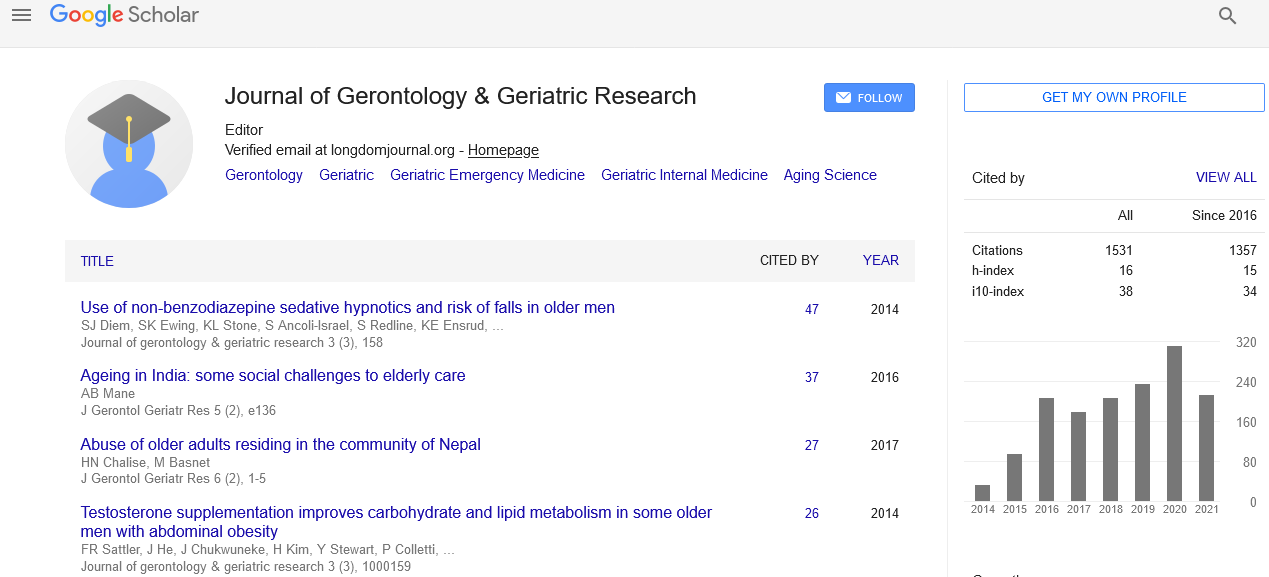PMC/PubMed Indexed Articles
Indexed In
- Open J Gate
- Genamics JournalSeek
- SafetyLit
- RefSeek
- Hamdard University
- EBSCO A-Z
- OCLC- WorldCat
- Publons
- Geneva Foundation for Medical Education and Research
- Euro Pub
- Google Scholar
Useful Links
Share This Page
Journal Flyer

Open Access Journals
- Agri and Aquaculture
- Biochemistry
- Bioinformatics & Systems Biology
- Business & Management
- Chemistry
- Clinical Sciences
- Engineering
- Food & Nutrition
- General Science
- Genetics & Molecular Biology
- Immunology & Microbiology
- Medical Sciences
- Neuroscience & Psychology
- Nursing & Health Care
- Pharmaceutical Sciences
EEG upper/low alpha frequency power ratio relates to cortex thinning in mild cognitive impairment
International Conference on Geriatrics & Gerontology
July 08-10, 2014 DoubleTree by Hilton Hotel Chicago-North Shore Conference Center, USA
Moretti Davide Vito
Accepted Abstracts: J Gerontol Geriat Res
Abstract:
Objective: Temporo-parietal cortex thinning is associated to mild cognitive impairment (MCI) due to Alzheimer disease (AD). The increase of EEG upper/low alpha frequency power ratio has been associated with AD-converter MCI subjects. We investigated the association of EEG upper/low alpha frequency power ratio with patterns of cortical thickness in MCI. Methods: 74 adult subjects with MCI underwent clinical and neuropsychological evaluation, electroencephalogram (EEG) recording and high resolution 3D magnetic resonance imaging (MRI). EEG upper/low alpha frequency power ratio as well as cortical thickness was computed for each subject. Three MCI groups were detected according to increasing tertile values of EEG upper/low alpha frequency power ratio and difference of cortical thikness among the groups estimated. Results: EEG high upper/low alpha frequency power ratio group had total cortical grey matter (CGM) volume reduction of 471 mm2, greater than EEG low upper/low alpha frequency power ratio group (p<0.001). EEG high upper/low alpha frequency power ratio group showed a similar but less marked pattern (160 mm2) of cortical thinning when compared to EEG middle upper/low alpha power ratio group (p<0.001). Moreover, EEG high upper/low alpha frequency power ratio group had wider cortical thinning than other groups, mapped to the Supramarginal and Precuneus bilaterally. No significant regional cortical thickness differences was found between middle and low EEG upper/low alpha frequency power ratio groups. Conclusion: High EEG upper/low alpha frequency power ratio was associated with temporo-parietal cortical thinning in MCI subjects. The combination of upper/low alpha frequency power ratio and cortical thickness measure could be useful for identifying individuals at risk for progression to AD dementia and may be of value in clinical context.
Biography :
Moretti Davide Vito is consultant Neurologist, chief of the clinical neurophysiology service and researcher at the National Institute of Research and Cure for Mental disorders and Dementia S john of God, Brescia, Italy. He received his medical degree from Catholic University in Rome and completed his residency in neurology and fellowship in movement disorders at University of Trieste, Italy. Moreover, he received the PhD in neurophysiology at La Sapienza University (tesis title ?Quantitative EEG in Alzheimer?s disease?). He is currently involved in research and care of subjects with Alzheimer?s disease and dementia in the Memory Clinic/Alzheimer Operative Unit of the S. John of God Institute. Moreover, he is the chief of the clinical neurophysiology unit. His research is primary concerned about quantitative EEG evaluation of Alzheimer?s patients both in prodromic and clinically evident phase of the disease.


